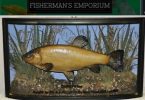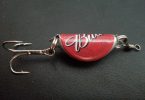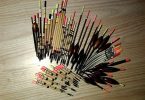What exactly is a ‘Super line’??? Well, this relatively new term refers to the new category of ultra low stretch, thin for their strength lines. These include lines made from Aramid – Kevlar/Technora, and the UHMWPE (Ultra High Molecular Weight Polyethylene) fibres like Dyneema and Spectra. They include both the braided and fused varieties. Brands include PowerPro, SpiderWire, SpiderWire Fusion, Fireline, and the vast assortment of European brands – DAM, Tortue, Ron Thompson, Climax, etc…. I am sure you will be hearing quite a bit about these new ‘Super lines’ over the coming months and years. Will these be revolutionizing the way we look at main lines??
I think that I should explain the difference between “Dyneema” and “Spectra” here:
Both ‘Spectra’ and ‘Dyneema’ are HDPE (High Density Polyethylene) fibres. However, Dyneema (Manufactured in Europe and Asia by Toyobo/Dyneema, DMS), is recognized as being of a slightly ‘lower quality’ than the American version “Spectra”. (The quality of Dyneema generally is very good). Also, the individual filaments that make up a Dyneema yarn are smaller than individual fibres in a spectra yarn; this translates to better abrasion resistance.
The older style Dyneema ‘braids’ (manufactured in Europe) have many inherent problems in their use. Often the advantages gained whilst using them were outweighed by their many drawbacks. These Dyneema braids include the ones currently being sold under various labels by the big UK carp fishing / specialist angling tackle suppliers.
You might be thinking that these braided lines are nothing new?? You are correct; many of these items have been on the market for nearly 10 years. Spiderwire, one of the original ‘Super lines’ had made its mark with many carp anglers (especially on the overseas circuits) in the early 1990’s.
The development of these new age ‘Super lines’ has obviously been a slow but steadily progressing area. Certain varieties have sprung up along the road to where we find ourselves now, from the excellent Spiderline (a type of ‘fusion braid’) to the newer Spectra/Dacron Hybrids.
The term ‘Fusion’ comes from where the line is heated in manufacture, enabling the fibre’s to become ‘fused’ together to some degree. This process removes many (but not all) of the problems found in the earlier varieties. But still, all was not resolved… Wind knots still caused problems if the caster was not ever vigilant to the amount of tension applied when slowing casts / retrieving these lines. Also common, was its tendency to fray. It seems these lines would start to get ‘furry’ after only a few sessions. This was a serious issue when you consider the cost of these lines. The ‘fusing’ aspect of these products seemed to solve the problem of ring wear also, but those nasty habits for knotting and tangles were still always present. The worst aspects to these ‘fused’ lines were their poor abrasion resistance.
I believe that the word fusion is misused in these products. (SpiderWire Fusion and Fireline) If you pull apart the line, you will find that the fibres in the structure are not fused with the exception perhaps of some fibres at the surface. They are coated with a plastic “skin” that binds the fibres together. The reason they get “Furry” is that the plastic skin is rubbed off the line, then the un-integrated fibres are exposed to every little abrasion and deteriorate quickly.
Incidentally, Spider Wire Fusion and Spectra lines should not be confused as being the same thing. Spectra line is soft and extremely flexible, whereas Spider Wire is stiff and hard, because its fibre’s are ‘fused’ together by heat as explained above. SpiderWire Fusion is made with Spectra Fibres, but the fused lines are not braided. Braided structures tend to have better abrasion resistance sine the fibres are held in place through the braiding process.
I remember my early experiences using braid, fishing in France on some of the mega large, snaggy reservoirs with Leon Hoogendijk, maybe 10 years ago now. We were using a fluorescent yellow braid, its abrasion resistance was fantastic but it was very thick and very tricky to deal with. All the baits had to be rowed out as there was no way you could cast it!! We were dying the last few meters with a permanent marker pen to be camouflaged as the lakebed. The braid was a semi buoyant variety, so we used a liquid ‘tungsten’ material to weight the last few meters down, putting a blob every meter or so. Thankfully things moved on at a steady rate, both sinking (Dyneema/Kevlar/Polyester), and semi buoyant conventional ‘Dyneema’ braids are now readily available in the UK marketplace.
The majority of braids that are currently in the carp fishing ‘market place’ are sinking versions. Some include ‘Kevlar’ in their make up, around 10-20%, this material is included to make the braid sink in the water, to some degree.
Kevlar (Para-Aramid fibre) is denser than water having a specific gravity of 1.38-1.44, unlike Dyneema, which has a specific gravity of 0.96 (Water is of course 1). The only ‘problem’ with Kevlar, is its negative reaction when exposed to UV light. Exposure to sunlight, over a long period of time, will reduce its strength by up to 40%, thereby lowering the overall ‘life’ of the line. Kevlar also stretches under tension, at a slightly different rate to that of Dyneema. This may cause undue stress on the Dyneema filaments making up the other 80% of the line, potentially causing a line failure. A similar problem was encountered when adding Dacron to Spectra (see below). Not something you want to hear when paying £60 odd for 600 metres!! Also Kevlar is very abrasive, not only to guides but also to itself. In dynamic bending, it is difficult to predict when Aramids will fail.
Other ‘sinking’ lines contain ‘Polyester’, in the same percentage amounts i.e.. 10-20%. This material is also added to make the finished product sink in the water. However, its abrasion resistant qualities are negligible, and it is added to the lines make up to reduce overall cost of manufacture. The only advantageous factor being, it does make the line sink.
The braid lines being sold under the labels of the big UK carp firms are generally manufactured in Europe (Holland) although, as I mentioned before, the quality of material used, Dyneema, is slightly inferior to that of Spectra.
No sinking version is, currently, manufactured in the US. Because they apparently have no need for one as they are mainly predator fishermen using lures. This does not mean however that one will not be coming on the market in the future. I understand ‘talks’ are in progress; we will have to wait and see on that one. But it will not contain either Kevlar or Polyester as, in my opinion, these materials are used to reduce manufacturing costs, as they are considerably cheaper to buy than Dyneema, which will set you back a ‘mere’ £2000 per Kilo, trade!
For the record, the reasons why I think the new ‘Super lines’ would be better to use than monofilament-fishing lines are this.
* The line will last longer than mono, thereby proving better value for money in the long run.
* It is infinitely better at transmitting movement / Vibration. Thereby improving sensitivity and bite registration.
* It is far thinner. Allowing the angler to cast further, and load more line on their reels.
Extensive analysis / field-testing of the new ‘Super lines’ both in the UK, USA and other parts of the world is proving very positive. Although we are still only in the early stages of actually ‘testing’ it in the European carp fishing environment, early feedback from those dozen or so highly respected anglers who have received samples has been very encouraging, to say the least. You may well have seen reviews in the angling press, for ‘Super lines’ such as the excellent, ‘Power Pro’ version.
The new Spectra braided ‘Super lines’ are unlike the braids currently on the market. They are not manufactured in the same way, and therefore do not behave in the same way, nor do they exhibit the inherent ‘problems’ encountered when Dyneema and ‘Fusion’ braids.
Unlike the older style braided lines, fishing with the new braided ‘Super lines’ is as easy as fishing with monofilament. Listed below are some of the immediate advantages of the new ‘Super lines’. Please note that I have used PowerPro as a benchmark:
* Rounder and more compact than other braided lines.
* Spools and packs better on any kind of reel
* Does not bury in the spool like the older style braids
* Smoother surface texture
* Sails effortlessly through your rod rings for longer casts
* Gentle on interior ring surfaces
* Significantly reduces wind knots & rod tip wraps
* Compact structure picks up less water
* Improved knot performance
And, also, provides all this without compromising the properties that anglers, who have used it, now come to appreciate in other ‘Super lines’:
* Near Zero Stretch
* Unbelievable strength for the diameter
* No reel memory
* Improved abrasion resistance
So how much does all this cost?? As an indicator, 150 yards of PowerPro retails at £16.99. A general lack of knowledge about the new ‘Super lines’ advantages seem to be their biggest downfall at the present time.
This new product brings with it many advantages over the older versions of braided Spectra. The most noticeable difference is that the samples of ‘PowerPro’ we’ve tested / used shows no inclination to break down and fray. Most anglers report much better abrasion resistance compared to the older style lines, but when you see any line fray, this means that fibres are breaking down, indicating that it’s time to retie. I would urge you to practice common sense…
With respect to abrasion resistance, ‘Super lines’ appear as abrasion resistant to a braid of the same diameter, regardless of test rating. Point being, a braids diameter is the major factor to whether it is resistant to abrasion or not. Spectra is just very good quality Dyneema.
That is why ‘Super lines’ are stronger, as far as diameter of line goes, than their competitors.
What I’m trying to put across, is that most ‘Super lines’ are as abrasion resistant as its equivalent diameter in a ‘normal’ braid. But its test is greater for the same diameter, a trade off if you like. So 50lb test would be as abrasion resistant as 30 lb ‘normal’ braid. For instance Fox sinking, Fireline etc. are thicker than, and contain more material than, ‘Super line’ of the same test. So, therefore, will be more abrasion resistant pro rata. If diameters came into it, Quicksilver 45 lb for example would probably rate, equivalent in diameter, to 100 lb test ‘Super line’. Abrasion resistance is very difficult to characterise since there are different types of abrasive media in the water. PowerPro for example is great against the barnacles found on the pilings of drill rigs, against Zebra Muscles, and many other structure, but really bad in Coral reefs where monofilaments do much better. As a general rule of thumb, it is safe to say that thicker lines will have better abrasion resistance. In the case of the fusion lines, you also have the issue of a non-integrated fibre bundle (twisted then coated), vs. a braided structure where the fibres are tightly held in the structure. The only analogy that I’ve been told is if you think of a cotton ball vs. a woven cotton cloth – if you rub a cotton ball over a surface the fibres are easily snagged and pulled out – in a woven cloth, the fibres are held in place and will not come apart.
Finally, if the marketing information / results from the US are true, you could well expect your new ‘Super line’ to last you a season or more with constant use!!
Remember, these lines are extremely thin which makes them very likely to cut into your fingers. Always use a finger guard or some form of decent protection on your casting finger and be extra careful if you are pulling free of snags by wrapping the line around your hand. Never wrap these Super lines around your hand. Wrap it around a stick, or the side plate of your reel before trying to remove a snag.
I think it is important to mention that I personally use a length of anti tangle tubing or lead core leader above the lead to avoid any possibility of damage to the fishes ‘flank’, although I have not encountered problems I would sooner be safe than sorry.
These ‘Super lines’ can, of course, be used in the capacity of a shock leader in conjunction with mono if required. I would suggest the use of a ‘Grinner to Grinner knot’ for this situation if tying on a leader of similar size. If you are tying a very large diameter monofilament leader too much thinner Super line, I recommend the Albright knot.
A few ‘tips’ on using new age ‘Super lines’ –
Spooling Up – Leave at least enough monofilament to cover the bottom of the spool. When you put monofilament onto your spool, it stretches significantly even with a very small amount of tension. This stretch makes the line squeeze the barrel of the spool, gripping it tight. The ‘Super lines’ don’t stretch, so you don’t get this gripping action on the barrel of the spool. Attach the mono to the ‘Super line’ using a ‘Grinner to Grinner knot’ as mentioned previously.
Getting a run – Exaggerated striking, even at big distances, such as you might require using monofilament is not necessary. Remember that every inch you move the tip of your rod is an inch of movement at the terminal arrangement (hook).
Following are some tips to reduce the incidence of whip knots while fishing with a spinning reel:
1. Do not overfill the reel – leave at least 1/8″ of rim at the top.
2. Close the bail arm manually.3. Before you begin your retrieve, pull on the line after you’ve closed the bail to make sure all the wraps are tight.
Pulling on the line only takes a second while you’re waiting for the bait to fall. This will reduce 90% of the problems!
Colouring ‘Super lines’ – The colour is simply there to encapsulate the fibre, and in time will wear off. This is normal, and the strength and performance of the line will not be affected, If you want to re-colour the line, simply take a permanent marker and colour the last few meters whatever colour best suits the situation you are fishing in.
‘Super lines’ as a hook length?
So what about using these new ‘Super lines’ as a hook length material?
Well, the answer has to be a yes! However, before we come to this conclusion, there is always the alleged problem / potential that braids can cause mouth damage. Some suggesting braids refusal to stretch under pressure plus, the very thin diameter of the braid acting almost like a ‘cheese wire’. Personally I’m not convinced, I have caught dozens of carp over the years utilizing braided hook lengths and braid as a mainline, very big fish included, and have seen no resulting damage.
I would like here to quote Tony Davies Patrick, who responded with the following, when posed with the question recently.
“I have used the 50 lb test braid (Spiderwire Spectra 2000) for hook lengths on thousands of fish and have never had problems with mouth damage. I use it and trust it. Only problem is that I can only get it in USA, and the bulk spools I need, it means a big lump out of my wallet!
But this is counter-acted by the fact that the line lasts, and lasts and lasts…”
Need I say more?? Well yes, the fact is that a 20 lb breaking strain super line is the equivalent of a 6 lb mono, a 50 lb ‘Super line’ equivalent to 12 lb mono, with diameters in mm being 0.15 and 0.36 respectively.
The ‘Super line’ is therefore significantly thinner in diameter than other conventional braids on the market at present.
For knotting your hook to a length of ‘Super line’ the ‘Palomar knot’ or 5 turn ‘Grinner knot’ is recommended.
PowerPro, which is manufactured by Innovative Textiles, Inc. appears at present to be by far the best new age ‘Super line’ on the market, most of the bad qualities which have been described above have been eliminated from Power Pro line.
Be warned though, as Spectra became more and more popular, a lot the other companies started selling their own version of it. Unfortunately, to save on costs, some of these companies blended Dacron with Spectra. This resulted in the line breaking well below its Test Rating. The breakage was due to the fact that the Dacron fibre’s stretched, whereas the Spectra fibres did not stretch, thus causing the Spectra fibres to break due to the fact that they were taking the majority of the strain.
To summarize, the new age ‘Spectra Fibre super braided fishing lines’ are awesome and definitely the line to use if sensitivity, high strength, good abrasion resistance and mega distances (if required) is what you are after.
I would like to take the opportunity to thank those ‘in the know’ who have assisted me with some of the technical details to make this article possible, you know who you are guys.
Tight ‘Super lines’!!!
Chris Woodrow
Chris ‘Essex Man’ Woodrow – 2001
www.essexangling.com








